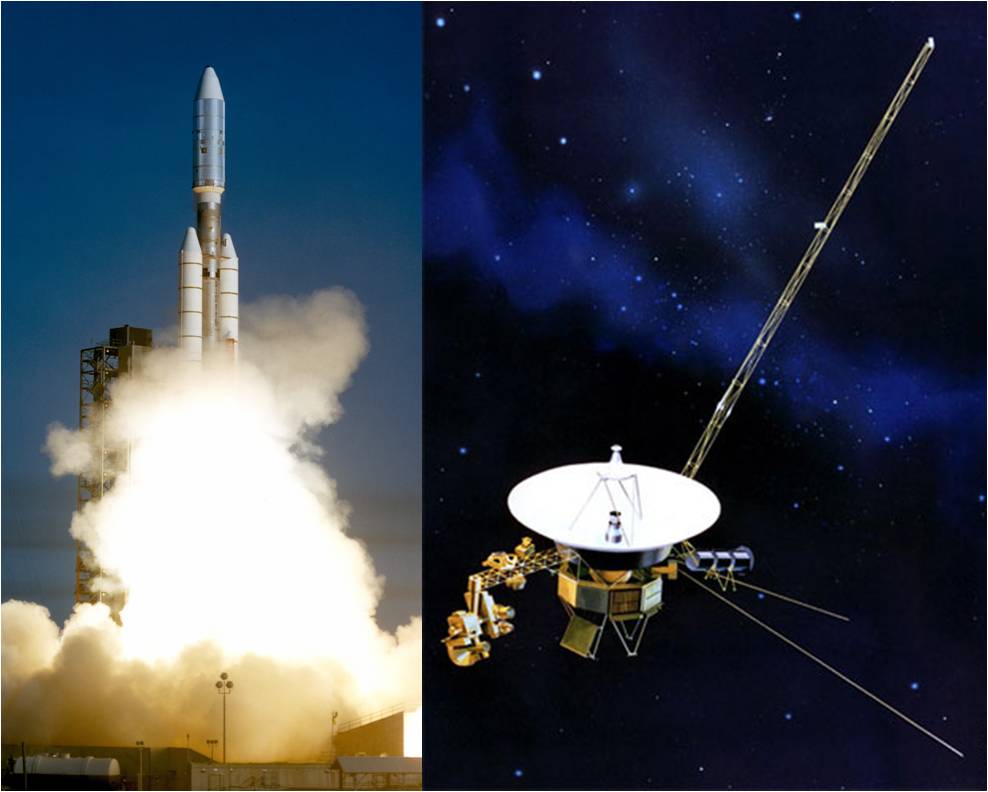Thirty-three years ago this week, the Voyager 1 space probe was launched on a first-ever mission to fly past the planets Jupiter and Saturn. Incredibly, both Voyager 1 and its companion Voyager 2 spacecraft continue to function quite well and transmit valuable data back to Earth as they voyage eternally in deep space.
The Voyager Program was a 1970’s NASA project to investigate the giant gas planets Jupiter and Saturn. Two (2) Voyager spacecraft were launched in the summer of 1977. Each probe was extensively instrumented to measure the planetary and space environments that they would encounter. Design lifetime was 5 years.
Due to a unique alignment of Jupiter, Saturn, Uranus and Neptune that occurs every 175 years, the Voyager Program had the potential to be much more than a two-planet journey. Specifically, a gravity assist at each planet could bend Voyager’s trajectory and send it to the next outermost planet in what was termed a Grand Tour of the Solar System’s giant gas planets.
And yet there was even more potential for scientific investigation beyond the Grand Tour! Given that either or both of the Voyagers continued to operate well beyond its/their design liftetime, the opportunity to investigate interstellar space itself would be a real possibility.
Voyager 1 was launched from Cape Canaveral’s LC-41 at 12:56:00 UTC on Monday, 05 September 1977. A Titan IIIE-Centaur launch vehicle provided the energy required to send the 1,588-pound spacecraft on its deep space mission. Interestingly, Voyager 1 launch delays resulted in Voyager 2 being launched several weeks earlier (i.e., Saturday, 20 August 1977).
Each Voyager spacecraft carries a 12-inch gold-plated copper record that includes terrestrial sights and sounds as well as a variety of human speech. The intent of carrying this record is to provide the finder, ostensibly the inhabitant of another celestial world, with information about and the location of our home planet.
Voyager 1’s quicker trajectory allowed it to arrive at Jupiter (05 March 1979) prior to the arrival of Voyager 2 (09 July 1979). Voyager 1 would proceed to flyby Saturn on 12 November 1980. Voyager 2 would fly the actual Grand Tour mission by visiting Jupiter, Saturn, Uranus and Neptune. This last encounter occurring on 25 August 1989.
As historic and momentous as was the completion of Voyager’s primary and extended planetary missions, there was more in store for the twin probes. Twelve (12) years after departing Earth, both spacecraft were operating amazingly well as they headed out of the Solar System. As a result, NASA established the Voyager Interstellar Mission (VIM).
The VIM is a tri-phase investigatory effort consisting of exploration of the Sun’s termination shock and heliosheath as well as the interstellar medium itself. Voyager 1 crossed the termination shock in December of 2004 at a distance of 8.74 billion miles from Earth. Voyager 2 achieved the same milestone in August of 2007 when it was 7.81 billion miles from Earth.
Both Voyager spacecraft are currently investigating the Sun’s heliosheath. Each is still sending back scientific data. Current estimates show that Voyager 1 and 2 will continue to function through at least 2025. The hope is that at least one of the spacecraft will have entered and probed interstellar space by that time.
Meanwhile, both Voyagers soldier-on at a Sun departure rate of 335 mllion miles per year for Voyager 1 and 307 million miles per year for Voyager 2. As of this writing, Voyager 1 is more than 10.66 billion miles from Earth, making it the most distant man-made object ever sent from Earth.

